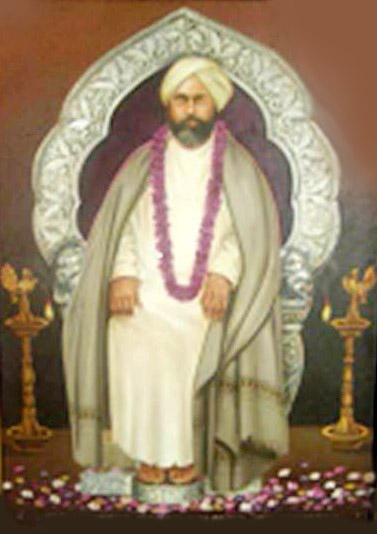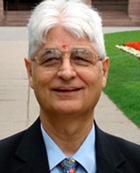His Holiness Swami Haldhar Ji Maharaj

|

His Holiness Swami Haldhar Ji Maharaj A Wath Sadh - abandon the Five Worldly Reactions (Kam, Krodh, Lobh, Moh, and Ahamkar) *KanayaLal Raina |
| Swami Haldhar Ji was an example of an ordinary man developing into a superman under very trying circumstances. Blessed indeed is the day When God made Swami Haldhar Ji entirely His own. He lived in his own-self and yet lived with masses around him. He has purified the faithful and with his all-pervading spirit continues to guide the needy and the deserving, even after attaining Mahasamadhi in 1921 on Ram Navami day. Swami Haldhar Ji Maharaj’s guru was Late Pandit Raja Ji, a saint of high order, his own brother-in-law. It is said that a seeker of God is doubly born. First he gets his birth from his parents and then the second birth from his guru who puts him on the righteous path. He met his real guru at a very young age and took up his apprenticeship under this great yogi, who lived in the foothills of the Himalayas at village Dayal, Anantnag and raised Swami Ji. For many years he remained attached with Pandit Raja Ji. Born and brought up in this atmosphere of learning, and true to his family tradition, became very learned in religious and secular fields. Swami Haldhar Ji took leave from his guru and started wandering in further pursuit of knowledge Divine and to intensify his meditative practices. It appeared that various villages in Kashmir exerted on him a strange fascination. He avoided the din and bustle of city life. In the year 1908, Swami Ji with his followers happened to come to village Budhmulla (Narvav) where our ancestors lived situated at the foothill of Ma-Sharika Koh, about 10 kilometres from Baramulla town. He showed his intent to stay at this place. Later upon his advice a huge full size deity of Nrisimha Avatar at village Zandefaran was excavated and various other deities of Lord Shiva’s family were also found, at village Fatehgarh, of the Pandavas period. A temple was built, and all the above deities, were installed near the house of our ancestors. Soon the entire village became a place of pilgrimage. Thousands of people started visiting our ancestor’s house to have darshan of Swami Ji after the temple was built. To accommodate more people new houses with large halls and deevankans were built, where more than 300 persons at a time would be served hot food from the daily Langer arranged for this purpose. Swami Ji was fond of devotional songs and music. Kirtans and bhajan mandalis were daily held in the prayer hall. He believed that when heart is filled with divine light, sweet and melodious tunes are sure to come out. Swami Ji would some time recite a new leela in Kashmiri and there were many followers / devotees who would write whatever Swami Ji would speak. All devotees were then offered rice and milk pudding (kheer). Swami Ji was basically a free thinker and was guided by direct experience and inner wisdom, Swami Ji never taught any particular religious doctrine. His concept of prayer was also unique. Swami Ji used to say “All pooja, aarti or namaz are good for nothing, if they give out the slightest odour of selfishness. He believed in making the inner senses pure, by sincerely remembering Him all the time through Satsang, Kirtans and bhajans. Swami Ji had occult powers, which he would rarely manifest. A vivid experience was seen when he desired to visit his guru Pandit Raja Ji, who had earlier initiated him to spiritualism. One day Swami Ji desired to meet his Guru who had come to Baramulla for a few days. Immediately arrangements were made and he was taken to Baramulla. It is said that when Swami Ji was about ½ kilometer away from the place of Raja Ji, his guru sensed the coming of Swami Ji and suddenly he directed his followers to close the door of the house. Soon thereafter Swami Ji arrived with his followers and found the door closed. He knocked at the door but to his surprise, Raja Ji wanted to know what type of a person had come to see him. Was he (kath sadh,) a Preacher, (bat sadh) Food Grabber or (wath sadh) Seeker of Truth? Swami Ji replied that he was a wath sadh treading the path of Righteousness and Truth. On hearing his reply the guru immediately opened the door and Swami Ji was allowed to enter into the house. He stayed there silently at the feet of his guru for an hour without uttering a single word and returned back to his place at Budhmulla along with his followers. It is said that Swami Ji knew about his last day of journey to Vaikunth. The disciples who were with him for the last days narrated later about the preparations that he had made for Mahasamadhi, although none imagined it to be so at that time. One day Swami Ji jokingly requested to arrange a fine “palki” as he had never sat in palki nor taken a ride earlier. A beautiful palki was made for him. Once it was ready, Swami Ji on his desire was carried in palki to Baramulla. From Baramulla, he desired to go to Sopore in Doonga which was arranged forthwith. When he arrived at Sopore, he directed the doonga towards Rishipeer temple, situated on the banks of river Jhelum, where he wanted to take some rest under a huge chinar tree. All the members accompanying Swami Ji stayed in the temple compound with him, under the chinar tree, where he performed his last meditation. Prior to the day of his attaining Mahasamadhi, he told his followers to wash the place with cow dung and spread the darbha around. He directed them to wake him up next morning just before the sunrise. He slept on the darbha grass all through out the night, where as followers’ recited bhajans and other verses dear to Swami Ji. Early in the morning on the day of Ramnavmi, in the year 1921 Swami Ji woke up, before sunrise. He took bath on the banks of river Jhelum, and went back to the place where the darbha grass was spread. He asked for a cup of tea and after taking the tea, sat on scattered darbha in his usual yogic posture and in this he mingled with the infinite and attained the abode no sooner the first ray of sun touched the ground. His achievement in sadhana was supreme. He had attained complete union with God. We are keen to know more about Swami Ji’s life from others as well, who may be anxious in paying tributes to his spiritual qualities and attainments. We are expressing adoration and acknowledging our faith in him as the sadguru. |
| |

*Kanayalal Raina is a Brampton based writer who contributes regularly to various Canadian publications. He is working as Executive Director at Canada Hindu Heritage Centre in Canada. An automobile Engineer and MBA (Mktg) by profession he is providing consultancy on Project Management, Financing and Marketing. |
| |
| Copyrights ? 2007 Shehjar online and KashmirGroup.com .Any content, including but not limited to text, software, music, sound,photographs, video, graphics or other material contained may not bemodified, copied, reproduced, republished, uploaded, posted, ordistributed in any form or context without written permission. Terms & Conditions. |